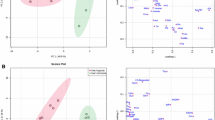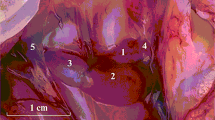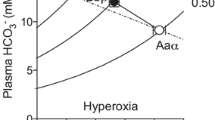Abstract
Medicinal leeches (Hirudo medicinalis L.) responded to self-induced hypoxia (72 h) with typical anaerobic metabolism characterized by a decrease in adenylate energy charge, utilization of the substrates glycogen and malate, and accumulation of the main anaerobic endproducts succinate and propionate. Propionate was also excreted into the medium. Ammonia excretion was suppressed. Aerobic recovery resulted in a profound O2 debt. Resynthesis of ATP was completed within 30 min. Disposal of succinate and restoring of malate required 2–3 h, and clearance of propionate and recharging of glycogen 6–12 h. Ammonia excretion did not exceed normoxic rates and excretion of propionate during recovery accounted for only 10% of total propionate accumulated during hypoxia. It is postulated that the clearance of succinate and propionate involves oxidation but also resynthesis of malate and glycogen. During hypoxia and recovery blood osmolality remained constant. The Na+ and Cl- ion concentrations in blood, the decrease of which was nearly equimolar during hypoxia, were re-established following different time-courses. Na+ concentration returned to normoxic levels after 2–3 h. The delayed increase in Cl- concentration, however, correlating with 6–12 h necessary to clear blood propionate, is interpretated as an anion regulating effect.
Similar content being viewed by others
Abbreviations
- AEC:
-
adenylate energy charge; fw, fresh weight
- HPLC:
-
high-performance liquid chromatography
- SCCA:
-
shortchain carboxylic acids
References
Bergmeyer HU (1984/1985) Methods of enzymatic analysis, vols VI–VIII. Verlag Chemie, Weinheim, Deerfield Beach, Fla, Basel
De Vooys CGN, De Zwaan A (1978) The rate of oxygen consumption and ammonia excretion by Mytilus edulis after various periods of exposure to air. Comp Biochem Physiol 60:343–347
De Zwaan A (1991) Molluscs. In: Bryant C (ed) Metazoan life without oxygen. St Edmundsbury press, Suffolk, UK, pp 186–217
Ellington WR (1982) Metabolic responses of the sea anemone Bundosoma cavernata (Bosc) to declining oxygen tensions and anoxia. Physiol Zool 55:240–249
Ellington WR (1983) The recovery from anaerobic metabolism in invertebrates. J Exp Zool 228:415–444
Hardewig I, Pörtner HO, Grieshaber MK (1992) The influence of hypercapnia on anaerobic propionate synthesis in the lugworm Arenicola marina. Verh Dtsch Zool Ges 85:20
Heereid CF (1980) Hypoxia in invertebrates. Comp Biochem Physiol 67A:311–320
Hildebrandt JP (1992) External CO2 levels influence energy yielding metabolic pathways under hypoxia in the leech Hirudo medicinalis. J Exp Zool 261:379–386
Hildebrandt JP, Zerbst-Boroffka I (1992) Osmotic and ionic regulation during hypoxia in the medicinal leech, Hirudo medicinalis L. J Exp Zool 263:374–381
Hipp E, Sedlmeier UA, Hoffmann KH (1984) Aerobic metabolic trends after anoxia in the freshwater oligochaete, Tubifex. Comp Biochem Physiol 78B:125–129
Hoeger U, Wenning A, Greisinger U (1989) Ion homeostasis in the leech: contribution of organic anions. J Exp Biol 147:43–51
Hoffmann KH, Seuss J, Hipp E, Sedlmeier UA (1986) Aerobic and anaerobic metabolism in Tubifex, a freshwater oligochaete. Zool Beitr 30:153–170
Hoffmann KH, Wulf A (1993) Comparative studies of integumentary uptake of short-chain carboxylic acids by freshwater oligochaetes. Comp Biochem Physiol 104A:169–174
Kamp G (1989) Biochemische und biophysikalische (NMR) Untersuchungen suchungen zur Regulation des anaeroben Energiestoffwechsels bei marinen Invertebraten. Habilitationsschrift, Universität Münster, Germany
Mustafa TJ, Seuss JB, Jorgensen JB, Hoffmann KH (1983) Gluconeogenesis in facultative anaerobic invertebrates: Evidence for oxalacetate decarboxylation and anaerobic end product incorporation into glycogen from tissues of Tubifex sp. J Comp Physiol 149:477–483
Pörtner HO, Surholt B, Grieshaber M (1979) Recovery from anaerobiosis of the lugworm, Arenicola marina L.: changes of metabolite concentrations in the body-wall musculature. J Comp Physiol 133:227–231
Pörtner HO, Andersen NA, Heisler N (1991) Proton-equivalent ion transfer in Sipunculus nudus as a function of ambient oxygen tension: relationships with energy metabolism. J Exp Biol 156:21–39
Putzer V, Gnaiger E, Lackner R (1985) Flexibility of anaerobic metabolism in aquatic oligochaetes (Tubifex sp.). Biochemical and calorimetric changes induced by deproteinized hydrolysate of bovine blood. Comp Biochem Physiol 82A:965–970
Putzer V, De Zwaan A, Wieser W (1990) Anaerobic energy metabolism in the oligochaete Lumbriculus variegatus Müller. J Comp Physiol B 159:707–715
Rajakylä E (1981) Separation and determination of some organic acids and their sodium salts by high-performance liquid chromatography. J Chromatogr 218:695–701
Robin Y, Roche J (1965) Reparation biologique des guanidines substituees chez des vers terrestres et d'eau douce (Oligochetes, Hirudinees, Turbellaries) recoltes en hongrie. Comp Biochem Physiol 14:453–461
Schöttler U, Bennet EM (1991) Annelids. In: Bryant C (ed) Metazoan life without oxygen. St. Edmundsbury Press, Suffolk, UK, pp 165–185
Schöttler U, Schroff G (1976) Untersuchungen zum anaeroben Glykogenabbau bei Tubifex tubifex M. J Comp Physiol 108:243–254
Schroff G, Schöttler U (1977) Anaerobic reduction of fumarate in the body wall musculature of Arenicola marina (Polychaeta). J Comp Physiol 116:325–336
Seuss J, Hipp E, Hoffmann KH (1983) Oxygen consumption, glycogen content and the accumulation of metabolites in Tubifex during aerobic-anaerobic shift and under progressing anoxia. Comp Biochem Physiol 75A:557–562
Seuss J, Hipp E, Höhenberger A, Hoffmann KH (1984) Physikalische, chemische und biologische Charakterisierung zweier Tubificiden-Standorte: Anpassungen im Energiestoffwechsel der Würmer an die natürlichen Lebensbedingungen. Archs Hydrobiol 100:45–59
Wegener G (1988) Oxygen availability, energy metabolism, and metabolic rate in invertebrates and vertebrates. In: Acker H (ed) Oxygen sensing in tissues. Springer, Berlin, Heidelberg, pp 13–35
Wichmann A (1993) Kalorimetrische Untersuchungen an Hirudo medicinalis L. während Normoxie, Anoxie und anschließender Erholung. Diplomarbeit, Fachbereich Biologie, Freie Universität Berlin, Germany
Wollenberger A, Ristau O, Schoffa G (1960) Eine einfache Technik der extrem schnellen Abkühlung größerer Gewebestücke. Pflügers Arch 270:399–412
Womersley C, Drinkwater L, Crowe JH (1985) Separation of tricarboxylic acid cycle acids and other related organic acids in insect haemolymph by high-performance liquid chromatography. J Chromatogr 318:112–116
Zebe E, Salge U, Wiemann C, Wilps H (1981) The energy metabolism of the leech Hirudo medicinalis in anoxia and muscular work. J Exp Zool 218:157–163
Zerbst-Boroffka I (1970) Organische Säurereste als wichtigste Anionen im Blut von Hirudo medicinalis. Z Vergl Physiol 70:313–321
Zurburg W, Bont AMT, Zwaan A de (1982) Recovery from exposure to air and the occurrence of strombine in different organs of the sea mussel Mytilus edulis L. Mol Physiol 2:135–147
Author information
Authors and Affiliations
Rights and permissions
About this article
Cite this article
Schmidt, H., Zerbst-Boroffka, I. Recovery after anaerobic metabolism in the leech (Hirudo medicinalis L.). J Comp Physiol B 163, 574–580 (1993). https://doi.org/10.1007/BF00302116
Accepted:
Issue Date:
DOI: https://doi.org/10.1007/BF00302116




